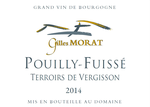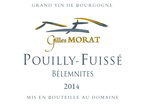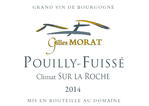
| See recent press for Gilles Morat
MACONNAIS - POUILLY-FUISSE
Gilles and Joelle Morat founded Domaine Gilles Morat in Vergisson in 1997. Gilles’ father and grandfather owned vines in Vergisson but had always sold their grapes to negociants. After 15 years in the electronics industry, Gilles decided it was time to move back to his home town so that his children would be able to enjoy the same life that he had while growing up. After spending one year in wine school in Davaye, Gilles combined his father's vines with additional parcels and began his new domaine. The winery is located high in village of Vergisson on a site known as “Châtaigneraie-Laborier” which denotes a 19th century plantation of chestnut trees (châtaignes) by a certain Monsieur Laborier. Morat chooses to keep the size of his domaine small (6 ha) so as to maintain an artisanal dedication to his vineyards and winemaking, while allowing the terroir of Vergisson to find full expression in his Pouilly-Fuissé cuvées. From the outset, Gilles’ vision was to bottle the majority of his production and make wine in the elegant and pure style which has become his hallmark. After some experimentation, Gilles found two local barrel makers who could provide him with the type of French oak barrels from the Allier and Cher forests that would enhance the style of wine he sought. The soil and site specific cuvées of Bélemnites and La Roche were launched in 2001. The Morat’s vineyards are all on the steep, east-facing amphitheater slopes of the commune of Vergisson, which is the very heart of the Pouilly-Fuissé appellation. The famed Roche de Vergisson is the defining landmark of this region, with the Rock of Solutré forming the southern limit of the cirque or amphitheatre. The altitude of the vineyards is a very high 300 to 450 (for the La Roche cuvée) meters. The soils are a mixture of clay and limestone, and vary in exact composition from parcel to parcel, a factor that adds complexity to the wines. Farming practices: Gilles Morat works his vineyards naturally. Only when needed, he applies minimal applications of organic fertilizer. He hand-plows the rows regularly, with different tools according to the season, and manually removes the grass directly under the vines. No pesticides, herbicides or anti-rot fungicides are used. Morat avoids problems on the vine by pruning strictly to keep yields low, constantly checking his vines during the growing season and using minimal copper-sulfite treatments only when needed. In early 2013, the Morat’s decided to apply for an official certification of their longstanding fully organic practices. It is expected in 2016. Harvesting is all done by hand at optimal maturity, with careful selection in the vineyard. The wines are raised entirely on their lees in barrels for 10 to 12 months. Alcoholic fermentation takes place in the barrels, and the wine is kept on its lees, which are periodically stirred to enhance flavor and nuance, throughout the elévage. Gilles Morat prefers Allier and Cher oak from the center of France for its fine texture. Bottling usually takes place just before the new harvest. |
| Gilles Morat Website |
 |
| Pouilly-Fuissé "Terroirs de Vergisson" |
| The perfect introduction to Gilles Morat’s precision-winemaking is his basic Pouilly-Fuissé AOC “Terroirs de Vergisson.” Vergisson’s vineyards are located on steep, amphitheater slopes between the famed rocks of Vergisson and Solutré, and are recognized as the appellation’s finest. Morat selects 100% Chardonnay grapes from several of his hillside Vergisson sites at 300-350 meters of altitude, each with different soils, for his first-level Pouilly-Fuissé. For this cuvée, Morat ferments and ages the wine in 60% stainless steel tanks and 40% barrels, which are between 4 and 8 years old and hence, do not impart oaky flavors. Morat’s goal is to produce a wine that shows the intensity and purity characteristic of outstanding vineyards and winemaking, but which is also very accessible upon release for its expressive and vivid fruit. The wine captures the unique character of its Vergisson terroir: pure and fresh, green apple, citrus and peach flavors with a soft minerality, imparting finesse and length. |
 |
| Pouilly-Fuissé "Bélemnites" |
| The Pouilly-Fuissé Bélemnites comes from various hillside parcels in Vergisson possessing a similar geologic characteristic: a high level of clay mixed with limestone and a large presence of fossils. The term “Bélemnites” refers to the principal type of these fossils. (A Belemnoid is an extinct squid ancestor common in ancient sea-beds from the Jurassic period. It is the hard part of their shells, called a “guard,” which forms the fossils.) Morat selects vineyard parcels with low-yielding 35-45 year old vines with this unique soil type. The Bélemnites cuvée is fermented and aged 100% in oak casks, of which 12% are new and the balance equally divided between 1-7 years of age, for 12 months. Morat stirs the lees once every two weeks and regularly tops-up the barrels to ensure freshness. Malolactic fermentation takes place spontaneously in barrels, usually beginning in the Spring. The Bélemnites cuvée offers generous aromas and flavors of citrus, citrus zest and apricot with purity, concentration and elegance. |
 |
| Pouilly-Fuissé "La Roche" |
| The Pouilly-Fuissé La Roche comes from a one-half hectare parcel of vines averaging 40 years of age situated on stony, limestone soil under the rock outcropping of Vergisson. The protected location, exposed to the south-east, allows for remarkable ripening; indeed, plant species are found here that are otherwise only in southern France. At an altitude of about 400 meters, the highest in the village, the vines are not affected by morning fog; rather they absorb all the heat of the day, which is relieved by cool nights. The high altitude helps preserve the wine acidity and freshness. The La Roche cuvée is fermented and aged 100% in oak casks, of which 12% are new and the balance equally divided between 1-7 years of age, for 12 months. Morat stirs the lees once every two weeks and regularly tops-up the barrels to ensure freshness. Malolactic fermentation takes place spontaneously in barrels, usually beginning in the Spring. The La Roche cuvée has an exceptional texture: intense, taut, rich and long with notes of smoke, green apple, citrus and minerals, while positively in the house style of purity and finesse. |
| Copyright © 2002-2017 VOS Selections, Inc. |